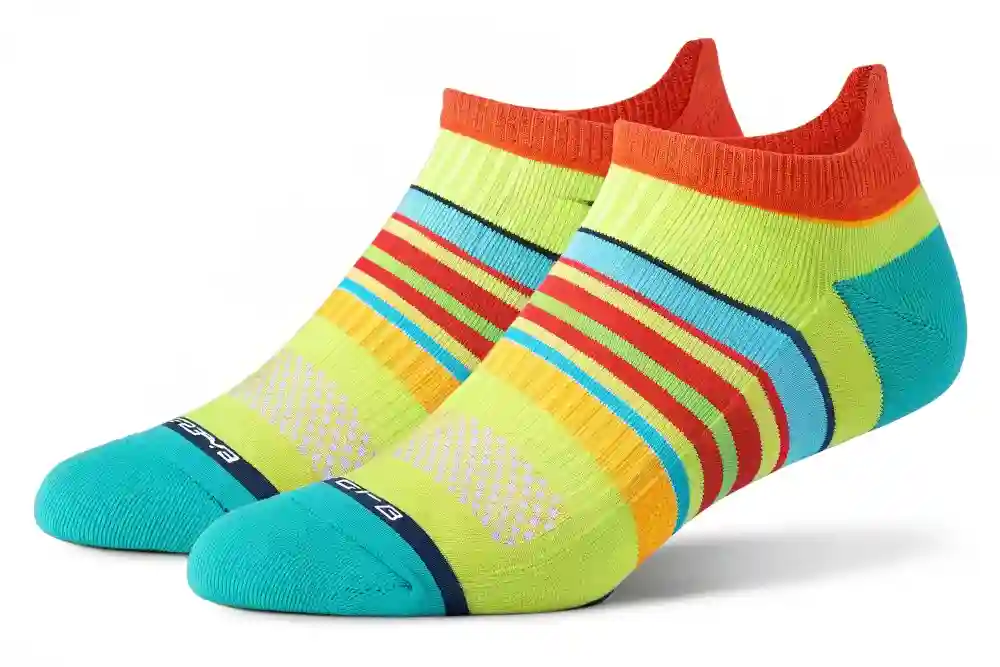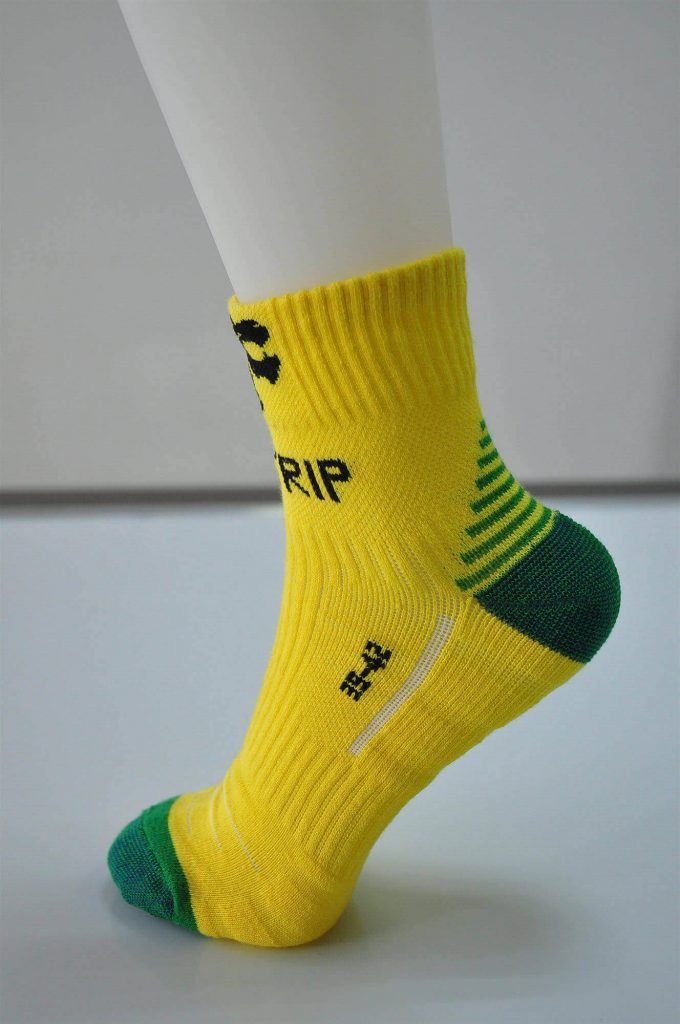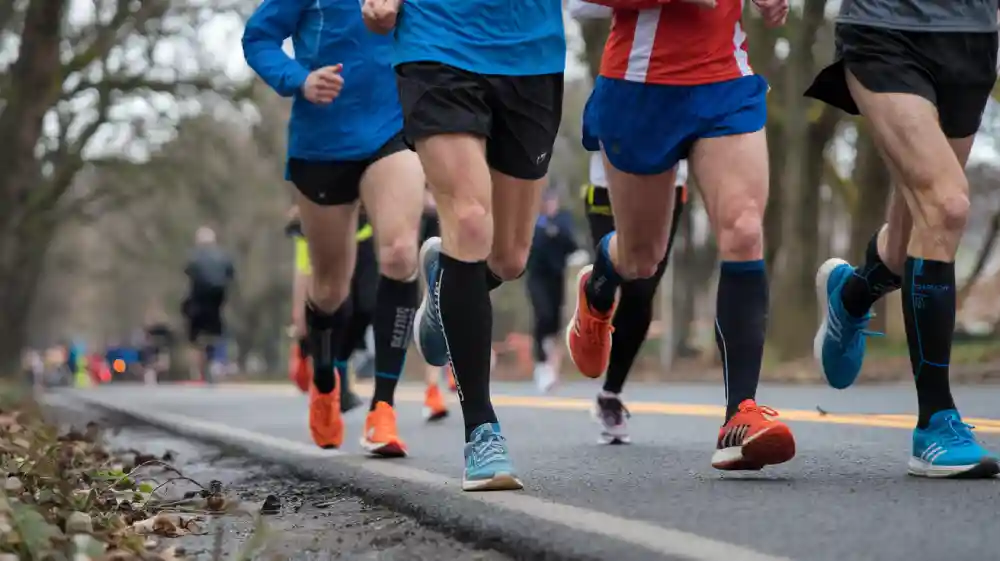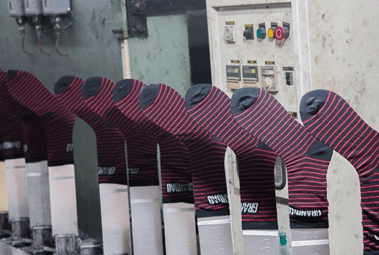Why Sweaty Feet Demand Better Running Socks
Sweaty feet are more than just an inconvenience—they’re a barrier to peak performance for runners and a hidden pain point for brands aiming to meet their customers’ needs. For every mile run, excessive moisture can lead to discomfort, blisters, and even long-term foot health issues. As a result, runners are constantly searching for socks that not only wick away sweat but provide support, breathability, and protection. If your brand isn’t offering running socks designed to combat these challenges, you’re missing out on a critical market opportunity.
The need for high-performance running socks is skyrocketing, with athletes and casual runners alike demanding better moisture management solutions. As foot health and comfort take center stage, the demand for specialized socks that elevate the running experience is growing. Brands that adapt and offer socks built for sweaty feet aren’t just selling products—they’re enhancing performance, increasing customer loyalty, and positioning themselves as leaders in a competitive market. Let’s dive into why your product line should include running socks designed specifically to tackle this issue and how it can transform your business.

Key Components of Effective Running Socks
Right materials
When designing socks for sweaty feet, selecting the right materials is crucial to balancing comfort, breathability, and durability. The ideal material should wick away moisture while ensuring long-lasting wear. Merino wool, synthetic blends, and bamboo are excellent choices. These fabrics not only help control moisture but also enhance breathability, keeping feet dry and cool during intense activities, which minimizes the risk of blisters and discomfort.
Ventilation zones
Strategically placed ventilation zones are equally important. Integrating mesh panels or open-knit patterns in key areas, such as the arch or toe box, helps increase airflow, allowing heat and moisture to escape. This thoughtful design helps regulate temperature inside the sock, ensuring comfort during long runs or workouts.
Anti-odor treatments
Anti-odor treatments are also essential for maintaining customer satisfaction. Sweat can lead to bacterial growth, which causes unpleasant odors. By incorporating odor-fighting technologies like silver ions or activated charcoal, socks can remain fresher for longer periods. This small yet effective feature enhances the user experience, ensuring that the socks meet the performance standards demanded by athletes and fitness enthusiasts alike.
Essential Features for Moisture-Control Running Socks
Moisture-Wicking Standards
When selecting socks for sweaty feet, moisture-wicking is the cornerstone of effective design. Retailers should ensure that their products meet high moisture-wicking standards to keep feet comfortable during exercise. Materials such as merino wool or advanced synthetics are ideal, as they quickly draw sweat away from the skin, preventing discomfort. Additionally, it’s important to verify that the moisture-wicking feature works throughout the entire sock, ensuring consistent dryness and reducing foot irritation during prolonged physical activity.
Seamless Construction to Minimize Blisters and Returns
Seamless construction is another vital feature for running socks. By eliminating seams, particularly in high-friction areas like the toe and heel, the risk of blisters is greatly reduced. A seamless design provides a smoother, more comfortable fit, minimizing irritation. This feature also helps retailers avoid customer complaints and returns, as blistering is one of the top causes of dissatisfaction with athletic socks.

Compression support
Compression support is a standout feature for performance-driven socks. Compression zones, particularly around the arch and ankle, improve circulation, reduce muscle fatigue, and enhance overall performance. This added support is particularly valuable during long runs or intense workouts, helping athletes to perform at their best and recover more quickly. Incorporating compression into your sock designs can attract customers looking for both comfort and functional performance.
Advanced Materials for Sweat-Resistant Socks
- Synthetic Blends: Benefits of Polyester and Nylon Combinations
Synthetic blends, particularly polyester and nylon combinations, offer numerous advantages for creating sweat-resistant socks. These materials are known for their moisture-wicking capabilities, quickly drawing sweat away from the skin to keep feet dry. Polyester, with its lightweight and fast-drying properties, helps reduce discomfort during intense physical activity, while nylon enhances durability and elasticity. Together, they provide a sock that performs well over time, resisting wear and tear while maintaining shape and comfort, even after multiple uses and washes.
- Natural Fibers: The Rise of Bamboo and Merino Wool
Natural fibers like bamboo and merino wool are becoming increasingly popular for their performance and sustainability. Bamboo offers excellent breathability and natural antibacterial properties, which help keep feet fresh and dry. Its moisture-wicking abilities make it an ideal choice for active individuals. Merino wool, with its unique temperature-regulating properties, helps maintain comfort by keeping feet cool in the heat and warm in colder weather. Both of these natural materials are gaining favor not only for their effectiveness in moisture control but also for their eco-friendly appeal.
- Silver Ion Technology for Long-Lasting Odor Prevention
Silver ion technology has become a game changer in odor control for socks. Silver ions, embedded within the fibers, help inhibit the growth of odor-causing bacteria. This technology provides lasting freshness, even after prolonged wear, making it especially beneficial for those who are active for long periods. Silver ions also have the advantage of being durable, ensuring that odor protection lasts for the lifetime of the sock. This feature is a key selling point for consumers looking for high-performance socks that stay fresh and comfortable throughout the day.
Targeting Different Runner Needs with Specialized Socks

Designing for Trail Runners vs. Road Runners
When designing socks for different types of runners, it’s important to consider their specific needs. Trail runners, for example, require socks that offer extra durability, cushioning, and support due to the more rugged terrain they encounter. Reinforced areas in the heel and toe, along with moisture-wicking materials, are essential to prevent discomfort. Cushioning in the arch and additional ankle support can help reduce foot strain during uneven stretches. Road runners, on the other hand, benefit from lightweight, breathable socks that emphasize comfort over long distances. A thinner, flexible design ensures freedom of movement, while moisture-wicking fabrics keep feet dry and cool.
Cold Weather Running Socks
Cold weather runners face the challenge of staying warm without overheating. For these conditions, socks need to provide insulation while still managing moisture effectively. Materials like merino wool offer natural warmth without causing feet to sweat excessively. Extra padding in the toes and soles is necessary for added comfort, but the sock should remain breathable to prevent cold feet due to trapped moisture. The balance of warmth and dryness is key for ensuring an optimal experience during winter runs.
High-Humidity Socks for Tropical and Summer Markets
In tropical or high-humidity regions, socks must focus on ventilation and moisture control. These conditions demand ultra-breathable designs with ventilation zones that allow airflow while keeping sweat at bay. Materials such as polyester blends or bamboo are ideal for their quick-drying properties, which ensure runners stay dry and comfortable even in extreme heat. These socks are engineered to offer a refreshing, cool experience during summer or tropical runs, preventing moisture buildup while promoting comfort.
Consumer Purchase Priorities: What Retailers Must Address
When considering consumer purchase priorities, fit is a top concern for runners. Retailers must ensure that socks offer a snug yet comfortable fit, avoiding tightness that causes discomfort and sagging that hinders airflow. A well-fitted sock enhances performance by reducing friction, while also allowing moisture to be managed effectively. Finding the right balance in fit, especially in areas like the arch and toe, is key. Retailers should emphasize the importance of sizing accuracy and provide guidance to ensure that customers get the right fit, reducing returns and enhancing satisfaction.
- Breathability
Breathability is another major consideration for runners. Socks with mesh panels or ventilation zones that increase airflow are essential in providing comfort during runs. These features allow moisture to escape, keeping feet dry and cool under intense activity. Proper breathability not only boosts comfort but also extends the life of the sock by preventing sweat buildup, which can lead to odor and deterioration. Offering socks designed for optimal airflow meets customer needs for high-performance gear.
- Thickness options
Thickness options are important for matching cushioning to the specific design of running shoes. Different shoes provide varying levels of support, so socks need to complement that. Retailers should offer a range of thicknesses, from lightweight options to thicker, cushioned socks that provide more comfort in supportive footwear. This variety enables customers to select the perfect pair based on their shoe type and personal preference, enhancing their overall running experience.
- Multi-pack pricing strategies
Finally, multi-pack pricing strategies can help drive volume sales. Many runners prefer stocking up on socks, and offering multi-packs at a value price can encourage bulk purchases. Retailers can cater to this demand, providing customers with convenience while also increasing sales. Multi-packs provide consistent quality at an affordable price, promoting customer loyalty and encouraging repeat business.
Adapting to Future Market Needs
Customizable design to stay competitive
As the running sock market continues to evolve, adapting to future needs is essential for staying competitive. One effective way to address this is by offering customizable designs that allow brands to stand out. Customization options, from color choices to logo placement, enable brands to create a unique product line that speaks to their target market. This feature is especially valuable for retailers aiming to appeal to specific customer groups, whether athletes, fitness enthusiasts, or casual runners, by offering tailored socks that reflect their brand identity.
Smart fabric innovations
Smart fabric innovations are also reshaping the market, especially for tech-forward retailers. New textile technologies allow for advanced features like temperature regulation and moisture control, while some socks even incorporate built-in sensors for performance tracking. These innovations provide significant value for consumers seeking high-performance gear that enhances their running experience. By offering smart socks that track metrics or adjust to the body’s needs, retailers can stay ahead of the curve, catering to a tech-savvy customer base eager for data-driven athletic wear.
Sustainability
Sustainability is becoming increasingly important, and consumers are now more focused on the environmental impact of the products they purchase. Offering socks made from sustainable materials, such as organic cotton, recycled fabrics, or biodegradable fibers, can help brands meet these growing expectations. Eco-friendly options not only appeal to environmentally conscious consumers but also position retailers as leaders in responsible manufacturing practices. By embracing sustainable materials, brands can tap into a rapidly expanding market segment that values both quality and ethical sourcing.
From Concept to Customer: The Step-by-Step Customization Process
The journey from raw materials to finished socks involves a detailed production process, with each step carefully designed to ensure quality, efficiency, and consistency. An optimized process can reduce production time, improve yield, and lower costs. Below is a breakdown of the key stages that transform your customized running socks from concept to product:
- Phase 1: Consultation and Material Selection (Tailored to Your Audience)
The process begins with a consultation to understand your specific requirements, such as sock type, intended use, and customer preferences. The material selection is crucial to achieving the desired performance. Whether you opt for cotton for comfort, polyester for moisture-wicking, or merino wool for warmth, each material plays a vital role. If custom colors are needed and pre-dyed yarns don’t meet your specifications, the dyeing process will take an additional 15-20 days. This phase ensures that raw materials align with functional needs and brand aesthetics.
- Phase 2: Prototyping and Testing (Ensuring Real-World Performance)
Once the materials are selected, a sample sock is created based on the specifications. This prototype undergoes thorough testing to evaluate factors like fit, moisture-wicking capabilities, breathability, and comfort. Real-world trials—such as wear tests that simulate long runs or different weather conditions—are essential in identifying potential issues. Based on this feedback, adjustments are made to ensure the final product meets your brand’s performance standards and consumer expectations.
- Phase 3: Bulk Production and Quality Assurance (Precision and Consistency)
After the prototype is approved, bulk production begins. At this stage, the focus shifts to maximizing output while maintaining quality. Machines are calibrated based on order volume and sock specifications—such as flat-knit or terry soles—affecting yield. The production process is closely monitored to ensure consistency in design, sizing, and performance. The first round of quality inspections is conducted to identify defects, such as pattern inconsistencies, size discrepancies, or material faults. If any issues arise, adjustments are made immediately to prevent defective products from continuing down the line.

- Phase 4: Packaging and Branding (Making Your Socks Shelf-Ready)
Once the socks are produced, they move to the final phase—packaging and branding. At this stage, socks are flipped inside out for toe-linking and undergo a final inspection. They are then shaped using a boarding process, ensuring they retain their form. The socks are placed on sock plates and heated using a setting machine to solidify their shape. Packaging options vary—ranging from OPP bags to branded color boxes—depending on your desired presentation. Custom branding, labels, and accessories like grips or embroidery are added to elevate the product’s appeal. Finally, the socks are paired, packed, and ready for shipment, making them shelf-ready for retailers and appealing to end consumers.
This step-by-step process ensures that every pair of customized running socks meets the highest standards, offering both performance and consistency while adhering to your timeline and budget.
Conclusion: Meeting Market Demand with Quality Solutions
The demand for high-performance running socks is growing, and offering socks that address moisture control, breathability, and durability is key to meeting consumer needs. By incorporating advanced materials like synthetic blends, merino wool, and silver ion technology, brands can deliver quality solutions that stand out in the market. Partnering with a trusted manufacturer ensures the product meets high standards, helping businesses meet demand and boost customer satisfaction. Contact us today to customize running socks that will elevate your product line and satisfy your customers’ needs.
FAQs
What’s the Minimum Order Quantity (MOQ) for Custom Designs?
The minimum order quantity for custom designs typically starts at 800 pairs per size and color. However, the MOQ can vary depending on the complexity of the design and materials selected. For larger quantities or mixed SKUs, the MOQ can be adjusted to accommodate your needs.
Can You Replicate Competitor Designs While Avoiding IP Issues?
While we can create socks similar in style or functionality, it’s essential to ensure that your designs are original or properly licensed. We encourage unique designs to avoid intellectual property issues and help you stand out in the market. Customization options allow you to tailor designs while respecting legal boundaries.
Why should I focus on moisture control and breathability when customizing socks?
Moisture control and breathability are essential for comfort and performance. Socks that manage sweat effectively help prevent discomfort, blisters, and foot odor, ensuring a better experience for runners and fitness enthusiasts.
What customization options are available for running socks?
When customizing running socks, you can choose from various options such as color, design, material, branding (e.g., logos and taglines), and patterns. You can also customize features like compression zones, ventilation panels, and toe-linking methods to suit specific performance needs.
Can I add my brand logo to the custom running socks?
Yes, your brand logo can be incorporated into the design of the socks. Whether it’s woven into the fabric, printed on the cuff, or included on the packaging, adding your brand logo helps increase visibility and brand recognition.
What Certifications Do Your Factories Hold for International Export?
- OEKO-TEX® Standard 100 (chemical safety)
- GRS (Global Recycled Standard) for sustainable claims
- ISO 9001 (quality management)
- BSCI audits (ethical labor practices)
These certifications mitigate customs delays in the EU, North America, and ESG-focused markets.
